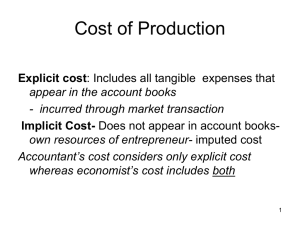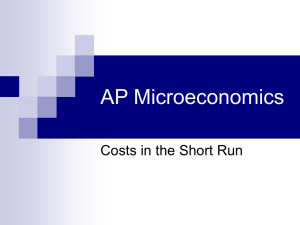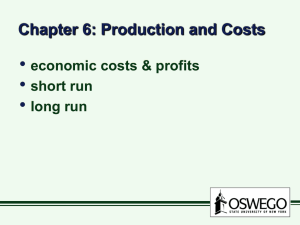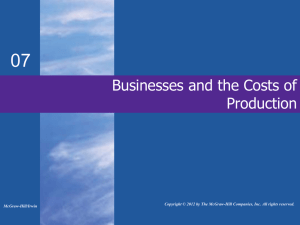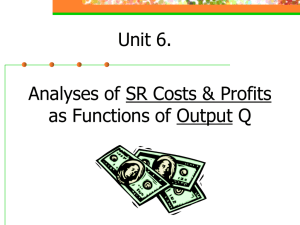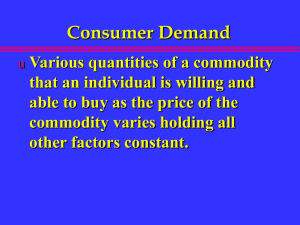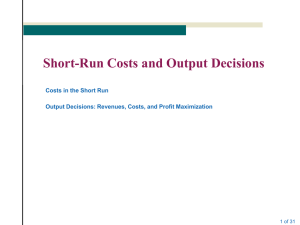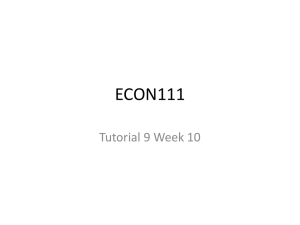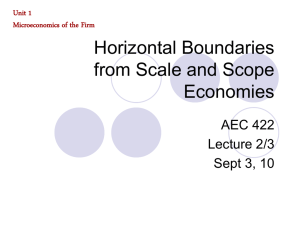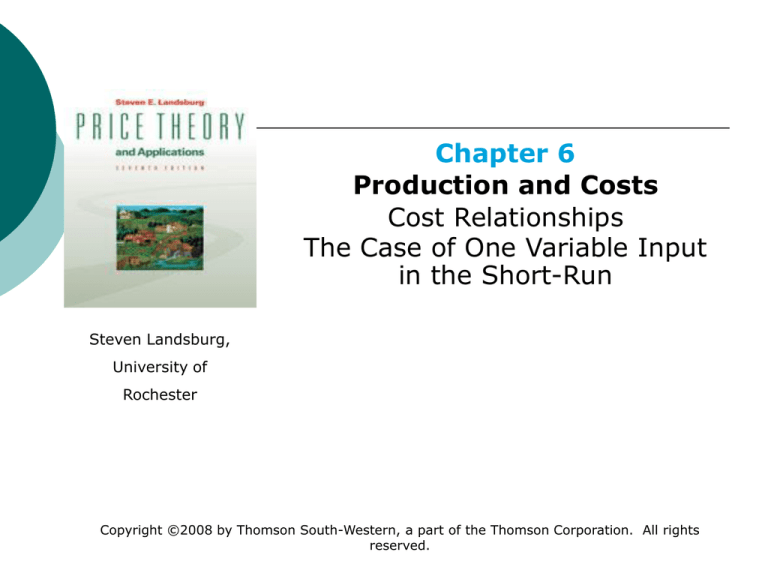
Chapter 6
Production and Costs
Cost Relationships
The Case of One Variable Input
in the Short-Run
Steven Landsburg,
University of
Rochester
Copyright ©2008 by Thomson South-Western, a part of the Thomson Corporation. All rights
reserved.
Cost Relationships
A manager’s goal is to determine how much to
produce to maximize profits.
We established earlier that Stage II is the rational
stage of production, but realized that cost and
revenue information is necessary to determine at
which point in Stage II to produce.
Now, let’s introduce cost relationships into
production.
Cost Definitions
Costs of Production or Economic Costs: The
payments that a firm must make to attract inputs and
keep them from being used to produce other products.
A firm’s cost functions show various relationships
between its costs and output rate. Thus, the firm’s
cost functions are determined by the firm’s
production function and input prices.
Since the production function can pertain to the
short run or the long run, it follows that the cost
functions can also pertain to the short run or the
long run.
Cost Functions in the Short Run
Fixed Costs: Costs which do not vary with the level
of production - These costs are associated with the
fixed factors of production. Incurred regardless
whether any output is produced
Variable Costs: Costs that vary as the output level
changes - These costs are associated with variable
factors of production.
Short-Run Cost Relationships
The Case of One Variable Input
Costs Based on Total Output
Total Fixed Costs (TFC): Costs of inputs that are
fixed in the SR & do not change as the output level
changes.
Total Variable Costs (TVC): Costs of inputs that
are variable in the Short Run, and change as output
level changes, i.e., TVC = PXX
Total Costs (TC): TFC + TVC
Total Cost Curves
(Assume TFC = $80 and Px = $25
0
Output: TFC
Q
0
80
TVC
0
TC =
TFC +
TVC
80
1
10
80
25
105
2
25
80
50
130
3
50
80
75
155
4
70
80
100
180
5
85
80
125
205
6
95
80
150
230
7
100
80
175
255
8
101
80
200
280
9
95
80
225
305
10
85
80
250
330
TOTAL FIXED COSTS
350
300
250
Cost
Input:
X
200
150
TFC
100
50
0
0
20
40
60
Output
80
100
120
Total Cost Curves
(Assume TFC = $80 and Px = $25
Output: TFC
Q
TVC
TC =
TFC +
TVC
0
0
80
0
80
1
10
80
25
105
2
25
80
50
130
3
50
80
75
155
4
70
80
100
180
TOTAL VARIABLE COSTS
300
TVC
250
200
Costs
Input:
X
150
100
TFC
50
5
85
80
125
205
6
95
80
150
230
7
100
80
175
255
8
101
80
200
280
9
95
80
225
305
10
85
80
250
330
0
0
20
40
60
Output
80
100
120
Total Cost Curves
(Assume TFC = $80 and Px = $25
0
Output: TFC
Q
0
80
TVC
0
TC =
TFC +
TVC
80
1
10
80
25
105
2
25
80
50
130
3
50
80
75
155
4
70
80
100
180
5
85
80
125
205
6
95
80
150
230
7
100
80
175
255
8
101
80
200
280
9
95
80
225
305
10
85
80
250
330
TOTAL COSTS
350
TC
300
250
Costs
Input:
X
TVC
200
150
100
TFC
50
0
0
20
40
60
Output
80
100
120
Total Cost Curves
TOTAL COSTS
350
TC
300
Costs
250
TVC
200
150
100
50
TFC
0
0
20
40
60
Output
80
100
120
Total Cost Functions
TFC = 100
TVC = 6Q – 0.4Q2 + 0.02Q3
TC = TFC + TVC = 100 + 6Q – 0.4Q2 + 0.02Q3
Average and Marginal Costs
Average Fixed Costs (AFC): Total fixed costs per unit of
output, i.e., AFC = TFC / Q
Average Variable Costs (ATC): Total variable cost per unit of
output, i.e., AVC = TVC/Q
Average Total Costs (ATC): Average total cost per unit of
output, i.e., ATC = TC / Y = AFC + AVC
Marginal Cost (MC): The increase in cost necessary to increase
output by one more unit, i.e.,
MC = ∆TC/∆Q
MC = (∆TVC + ∆ TFC) / ∆Q
MC = ∆TVC / ∆Q
MC = ∂TC/ ∂Q = ∂TVC/ ∂Q
Average Fixed Costs: AFC = TFC/Q
X
Q
TFC
0
0
80
AFC
1
10
80
8
2
25
80
3.20
Average Fixed Costs
9.00
8.00
3
50
80
1.60
4
70
80
1.14
6.00
5
85
80
0.94
5.00
6
95
80
0.84
4.00
7.00
3.00
7
100
80
0.80
8
101
80
0.79
1.00
9
95
80
0.84
0.00
10
85
80
0.94
2.00
AFC
0
20
40
60
80
100
120
Average Variable Cost: AVC = TVC/Q
X
Q
TVC
0
0
0
AVC
0
1
10
25
2.50
2
25
50
2.00
3
50
75
1.50
4
70
100
1.43
5
6
85
95
125
150
1.47
1.58
7
100
175
1.75
8
101
200
1.98
9
10
95
85
225
250
2.37
2.94
Y
TVC
0
0
10
25
25
50
50
75
70
100
85
125
95
150
100
175
4
101
200
3
95
225
2
85
250
1
AFC
Average Variable Cost
9
8
7
6
AVC
5
0
0
20
40
60
80
100
120
Average Total Cost: ATC=TC/Q
X
Q
0
0
80
1
10
105
10.50
2
25
130
5.20
3
50
155
3.10
12
4
70
180
2.57
10
5
85
205
2.41
8
6
95
230
2.42
6
7
100
255
2.55
8
101
280
2.77
9
10
95
85
TC
305
330
ATC
3.21
3.88
Average Total Cost
ATC
4
AVC
2
AFC
0
0
20
40
60
80
100
120
Marginal Cost: MC = ∂TC/ ∂Q
X
Q
0
0
1
10
TC
MC
80
105
Marginal Cost
2.50
15
2
25
130
1.67
3
50
155
1.00
11
4
70
180
1.25
9
5
85
205
1.67
7
6
95
230
2.50
5
7
100
255
5.00
3
8
101
280
25.00
13
95
305
10
85
330
ATC
AVC
AFC
1
-10 -1
9
MC
10
30
50
70
90
110
Summary of Relationships Between ShortRun Cost Curves
AFC is a continuously
decreasing function
AVC & ATC curves are
U-shaped
The vertical distance
between ATC & AVC at
each output level is equal
to AFC
MC crosses both AVC &
ATC from below at their
respective minimums
MC is not affected by
fixed costs
Relationships Among Cost Curves
TOTAL COSTS
TC
350
300
TVC
Costs
250
.
Inflection Point
200
150
100
.
.
TFC
50
0
0
20
40
60
80
100
120
Output
MC
ATC
Costs/unit
AVC
AFC
Output
Changes in Input Price
Increase in the Price of the Variable Input
The cost of producing each output level increases
VC & TC shift upward & left; TFC remains
unchanged
AVC, AC, & MC shift upward & left
Decrease in the Price of the Variable Input
The cost of producing each output level decreases
TVC & TC shift downward & right; TFC remains
unchanged
AVC, ATC, & MC shift downward & right
Relationships among Product Curves and
Cost Curves
The cost curves are derived directly from the
production process.
TP & TVC, AP & AVC and MP & MC are
mirror images of each other
Therefore, the production function can be
transferred directly to the cost curves
The three stages of a production function can be
transferred directly to the cost curves
Relationship Between TPP and TVC
TP
TVC
120.00
300.00
100.00
250.00
80.00
200.00
B
60.00
TPP
150.00
TVC
100.00
40.00
A
20.00
50.00
B*
A*
25
0.00
0.00
2.00
4.00
6.00
8.00
10.00
12.00
0.00
0.00
20.00
40.00
60.00
80.00
100.00
120.00
The TVC is derived from the TP: At “A” on TP, 25 units of the output is being produced with 2 units of
the input. The corresponding point “A*” on the TVC shows that the variable cost of producing 25 units
of output is $50 (PX:$25 * 2 units of input =$50). Note similar linkage between point “B” on TP and
point “B*” on TVC.
Similar relationships can be derived between AVC & APP and between MPP & MC.


